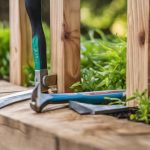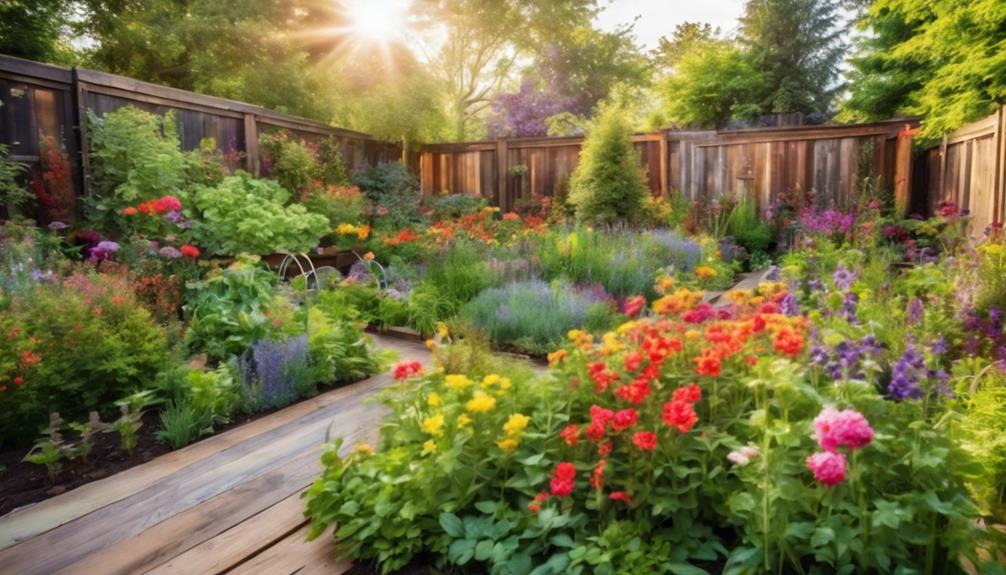
Why Choose the Right Fencing Installation Contractor?
24 September 2024
What Makes Fencing Key for Garden Makeovers?
24 September 2024Fencing is essential for urban gardening spaces as it enhances security, providing a barrier against theft and vandalism.
It also protects crops from wildlife, ensuring the integrity of plants and maximising yield.
The choice of durable materials not only contributes to aesthetic appeal but also increases property value.
In addition, thoughtfully designed fencing supports effective garden layout and pest management strategies.
By creating a controlled environment, fencing promotes healthier growth and productivity in urban gardens.
Exploring these factors further will reveal how fencing can significantly influence the success of your gardening endeavours.
Fencing Enhances Urban Garden Security
Fencing plays an essential role in enhancing the security of urban gardens by preventing animal intrusion and protecting plants from potential damage.
Furthermore, a well-constructed fence serves as a deterrent against theft and vandalism, safeguarding the investment of time and resources made by urban gardeners.
Prevents Animal Intrusion
While urban gardens can thrive in densely populated areas, the threat of animal intrusion poses a significant challenge to their sustainability and productivity.
Fencing serves as a critical barrier, effectively deterring a range of animals such as rabbits, deer, and squirrels, which can wreak havoc on crops and delicate plants.
By establishing a well-constructed enclosure, urban gardeners can create a controlled environment that safeguards their investments and boosts yield.
The choice of fencing material—be it chain-link, wooden, or vinyl—should be tailored to the specific fauna prevalent in the area, ensuring durability and effectiveness.
Moreover, height and design considerations must be made to prevent climbing or burrowing, reinforcing the garden's integrity.
Ultimately, a robust fence is an indispensable asset for the success of urban gardening.
Deters Theft and Vandalism
In urban environments, the risk of theft and vandalism can pose serious threats to community gardens and individual plots alike. Installing sturdy fencing serves as a vital deterrent, effectively signalling that the space is protected and monitored.
Beyond merely creating a physical barrier, well-designed fences can improve visibility and foster a sense of community ownership, which further discourages criminal activity. Furthermore, fencing can incorporate features such as lockable gates and surveillance options, providing additional security measures.
Fencing Material Durability
When considering the durability of fencing materials, several factors come into play, including their ability to deter pests and withstand environmental conditions.
The height and visibility of the fencing not only influence its effectiveness as a barrier but also contribute to the overall aesthetic appeal of the urban garden.
Selecting durable materials can enhance both the functionality and visual harmony of the gardening space.
Pest Deterrence Through Fencing
How can the choice of fencing material significantly affect pest deterrence in urban gardening spaces?
The durability and design of fencing materials influence their effectiveness in repelling pests. Various materials present distinct advantages in creating a formidable barrier against unwanted intruders.
- Wood: Visually appealing but may require treatment to resist decay and pests.
- Metal: Extremely durable and resistant to gnawing, making it a robust option.
- Vinyl: Low maintenance and impervious to moisture, providing long-lasting protection.
- Composite: Merges the benefits of wood and plastic, offering resilience and pest resistance.
Choosing the appropriate fencing material not only enhances the longevity of the garden space but also significantly reduces the likelihood of pest infiltration, thereby safeguarding cultivation efforts.
Height and Visibility Considerations
Effective fencing in urban gardening spaces requires careful attention to both height and visibility, as these factors play a crucial role in the overall durability and functionality of the barrier.
The choice of material significantly impacts the lifespan and maintenance needs of the fencing, while considerations regarding height influence both security and plant protection.
Visibility is equally important; overly tall fences can obstruct light, while low fences may fail to deter unwanted intrusions.
Key considerations include:
- Material Resistance: Opt for weather-resistant materials such as vinyl or treated timber.
- Height Optimisation: Aim for heights between 1.2 to 1.8 metres for effective deterrence.
- Visibility Maintenance: Design with transparency in mind to allow sunlight penetration.
- Structural Integrity: Ensure robust construction to withstand urban environmental challenges.
Aesthetic Appeal of Fencing
The aesthetic appeal of fencing in urban gardening spaces significantly influences the overall design and harmony of the environment.
Durable fencing materials not only enhance visual attractiveness but also contribute to the longevity and functionality of the gardens.
Choosing the right fencing can create a cohesive appearance that complements the surrounding architecture while safeguarding valuable green spaces.
The selection of materials plays a crucial role in achieving this balance.
- Natural Wood: Provides a rustic charm and blends seamlessly with plant life.
- Metal: Offers a modern, sleek finish while ensuring durability.
- Composite Materials: Combines aesthetics with low maintenance and longevity.
- Vinyl: Available in multiple styles, it effectively mimics traditional fencing appearances with enhanced resilience.
Selecting Appropriate Fencing Type
When selecting the appropriate fencing type for urban gardening spaces, it is crucial to assess your garden's layout to ensure ideal functionality and aesthetics.
Considering regular maintenance schedules will help determine the most suitable materials and designs that align with your gardening practices.
Furthermore, exploring vertical gardening fencing solutions can enhance space while providing necessary support for climbing plants.
Assess Your Garden's Layout
How does the layout of your garden influence the type of fencing you choose? A carefully considered garden layout can dictate fencing requirements based on factors such as accessibility, aesthetics, and functionality.
For instance, a garden with multiple sections may necessitate varied fencing types to delineate spaces effectively.
- Height Requirements: Taller fences may be needed for privacy or security in densely populated areas.
- Material Compatibility: Choose materials that complement your garden's design and neighbouring structures.
- Access Points: Consider gates and entryways that integrate seamlessly into your layout.
- Wildlife Considerations: Different fencing types can deter or accommodate local wildlife, depending on your gardening goals.
These elements ensure that your fencing choice aligns harmoniously with your garden's overall design and purpose.
Regular Maintenance Schedules
Selecting the appropriate fencing type not only enhances the aesthetics and functionality of your urban garden but also dictates the maintenance schedule required to keep it in optimal condition.
Different materials necessitate distinct levels of upkeep; therefore, understanding the implications of your choice is vital for long-term sustainability.
- Wood: Requires regular staining or sealing to prevent rot.
- Vinyl: Low-maintenance but may need occasional cleaning to remove dirt and mildew.
- Metal: Often durable but may require rust treatments and repainting.
- Natural Barriers: Such as hedges, call for pruning and pest management to thrive.
Vertical Gardening Fencing Solutions
Vertical gardening has emerged as an inventive solution for maximising space in urban environments, and choosing the right type of fencing is crucial for its success. The selected fencing not only supports the plants but also enhances the aesthetic appeal of the garden.
When evaluating fencing options, consider the following:
- Material Durability: Select weather-resistant materials such as aluminium or treated timber to withstand urban elements.
- Height and Stability: Ensure the fencing is tall enough to support climbing plants while maintaining stability against winds.
- Design Versatility: Opt for designs that complement your garden's theme and allow for easy integration of vertical planters.
- Accessibility: Choose fencing that provides easy access for maintenance and harvesting, facilitating a productive gardening experience.
Increased Property Value Enhancement
Many homeowners may not realise that enhancing their urban gardening spaces with effective fencing can significantly boost property value. Fencing not only provides security and privacy but also improves the aesthetic appeal of the property, making it more attractive to potential buyers. A well-designed fence can delineate garden boundaries while contributing to a cohesive landscape.
| Fencing Type | Value Increase | Aesthetic Benefit |
|---|---|---|
| Wooden Fencing | High | Natural look |
| Wrought Iron Fencing | Moderate | Elegant and timeless |
| Vinyl Fencing | Moderate to High | Low maintenance appeal |
| Living Fences | High | Eco-friendly, lush appearance |
Fencing for Garden Layout Design
Effective garden layout design is essential for maximising the productivity and aesthetics of urban gardening spaces.
Incorporating fencing elements such as companion planting support structures, vertical plant support systems, and pollinator-friendly options can enhance both plant health and biodiversity.
Companion Planting Support Structure
Integrating companion planting into urban gardening requires a well-considered support structure, often facilitated by fencing that delineates garden layouts.
This strategic use of fencing not only establishes boundaries but also enhances the symbiotic relationships between plants. Properly designed fencing can optimise sunlight exposure and airflow, both of which are essential for the health of companion plants.
Key considerations for implementing companion planting support structures include:
- Plant Compatibility: Selecting pairs that benefit from one another's growth patterns.
- Microclimates: Utilising fencing to create sheltered areas that support sensitive plant varieties.
- Soil Health: Encouraging biodiversity through integrated pest management.
- Aesthetic Appeal: Designing fences that harmonise with the overall garden theme while promoting plant interaction.
Such a thoughtful approach cultivates both productivity and visual harmony in urban gardens.
Vertical Plant Support Systems
Vertical plant support systems are essential components in the design of urban garden layouts, enabling optimal space utilisation and enhancing plant growth.
These systems elevate plants off the ground, promoting better air circulation and sunlight exposure, which are fundamental for healthy development. Furthermore, they reduce soil compaction and facilitate easier maintenance.
- Maximises limited space by encouraging vertical growth.
- Enhances aesthetics, creating visually appealing garden structures.
- Increases accessibility for harvesting and tending to plants.
- Supports a diverse range of plant varieties, including climbing vegetables and flowering vines.
Incorporating vertical plant support systems into urban gardens not only boosts productivity but also fosters a dynamic and engaging gardening experience, vital for urban horticultural success.
Pollinator-Friendly Fencing Options
In urban gardening, the integration of pollinator-friendly fencing options plays an essential role in enhancing the overall ecosystem of garden spaces.
Such fencing not only serves as a boundary but also promotes biodiversity by providing habitats and food sources for pollinators. Selecting the right materials and designs can significantly influence the health of surrounding flora and fauna.
- Trellis Fencing: Supports climbing plants while offering shelter for beneficial insects.
- Native Plant Borders: Incorporates local flora that attracts pollinators.
- Hedge Fencing: Creates a dense barrier that provides nesting sites.
- Bee Hotels: Integrated structures within fencing to encourage solitary bees.
Adopting these options fosters a balanced environment, ultimately contributing to the overall vibrancy of urban gardens.
Pest Intrusion Mitigation Strategies
In urban gardening, protecting plants from pests is essential for maintaining healthy crops.
Implementing effective wildlife barriers can significantly reduce intrusion from common nuisances such as rabbits and deer.
This discussion will examine various strategies for installing barriers that are both efficient and sustainable in urban environments.
Wildlife Barrier Installation
How can urban gardeners effectively safeguard their plots from unwelcome wildlife intrusions? Implementing a robust wildlife barrier is crucial for protecting cultivated spaces from various pests.
A thoughtful installation of fencing can serve as a formidable deterrent to animals seeking food or shelter. Here are key strategies to consider:
- Select Appropriate Materials: Use durable, weather-resistant materials suited to the local wildlife.
- Ensure Proper Height: Install barriers that are tall enough to prevent jumping or climbing.
- Bury the Base: Extend the fencing underground to deter burrowing animals.
- Incorporate Visual Deterrents: Enhance barriers with reflective surfaces or natural repellents.
Effective Barriers Against Rabbits
A variety of effective barriers can significantly reduce rabbit intrusion in urban gardens, safeguarding crops from these persistent pests.
Implementing strategic measures ensures that the integrity of your gardening efforts remains intact.
- Fencing Solutions: Utilise hardware cloth or chicken wire, buried at least 15 centimetres underground to deter digging.
- Plant Selection: Incorporate aromatic or bitter herbs and flowers that rabbits typically avoid.
- Companion Planting: Arrange plants that repel rabbits alongside more vulnerable crops.
- Physical Deterrents: Use motion-activated sprinklers or noise devices to create an uncomfortable environment for rabbits.
Effective Fencing for Deer Prevention
While rabbits can pose a significant threat to urban gardens, deer present an even greater challenge due to their size and voracious appetite. Effective fencing is essential in safeguarding urban gardening spaces from these large herbivores.
The following strategies can enhance the effectiveness of deer prevention fencing:
- Height: Install fencing at least 2.4 metres tall to deter jumping.
- Material: Use sturdy materials such as woven wire or high-tensile fencing to withstand pressure.
- Design: Incorporate angled tops or overhangs to further discourage access.
- Visibility: Ensure the fence is visually imposing, as deer are less likely to approach barriers that seem formidable.
Implementing these strategies can yield significant results in protecting urban gardens from deer intrusion.
Why Choose TKL Birmingham Gardener
Choosing TKL Birmingham Gardener for your urban gardening needs guarantees a blend of expertise and tailored solutions.
With a profound understanding of local flora and fauna, TKL Birmingham Gardener specialises in creating fencing solutions that not only enhance the aesthetic appeal of your garden but also provide essential protection against pests.
Their team employs innovative techniques and high-quality materials, ensuring durable and effective barriers that cater specifically to urban environments.
TKL Birmingham Gardener prioritises customer collaboration, conducting thorough assessments to design fencing that aligns with individual gardening aspirations.
This commitment to excellence fosters an environment where urban gardening can flourish, allowing you to cultivate your green space with confidence and mastery, free from the threats posed by wildlife and other external factors.
Common Fencing Questions Answered
Understanding the intricacies of fencing for urban gardening is vital for any gardener looking to protect their green space effectively. A common question pertains to the best materials; options such as wood, vinyl, and metal each offer unique advantages, with wood providing natural aesthetics and metal ensuring durability.
Another frequent inquiry concerns height regulations; local ordinances often dictate maximum heights, which can affect privacy and security. Moreover, gardeners frequently ask about maintenance; selecting low-maintenance materials can reduce long-term costs and labour.
Cost is also a prevalent concern—budgeting appropriately requires understanding both the initial investment and potential upkeep. Lastly, many inquire about installation; professional guidance can guarantee ideal placement and effectiveness, maximising the benefits of your fencing solution.
Fencing Boosts Garden Productivity
Implementing effective fencing in urban gardening spaces considerably boosts productivity by creating a controlled environment.
A well-designed fence serves not only as a protective barrier but also improves the overall health and yield of the garden. By limiting access to pests and providing a structured growing area, gardeners can optimise their cultivation efforts.
Key benefits of fencing include:
- Pest Deterrence: Fencing acts as a physical barrier against rodents and other garden nuisances.
- Microclimate Creation: It can help regulate temperature and humidity, fostering a more favourable growing environment.
- Soil Protection: Fencing minimises soil erosion and compaction from foot traffic.
- Space Optimisation: Clearly defined boundaries allow for efficient layout planning and crop rotation strategies.
Incorporating fencing is, therefore, crucial for maximising urban gardening productivity.




